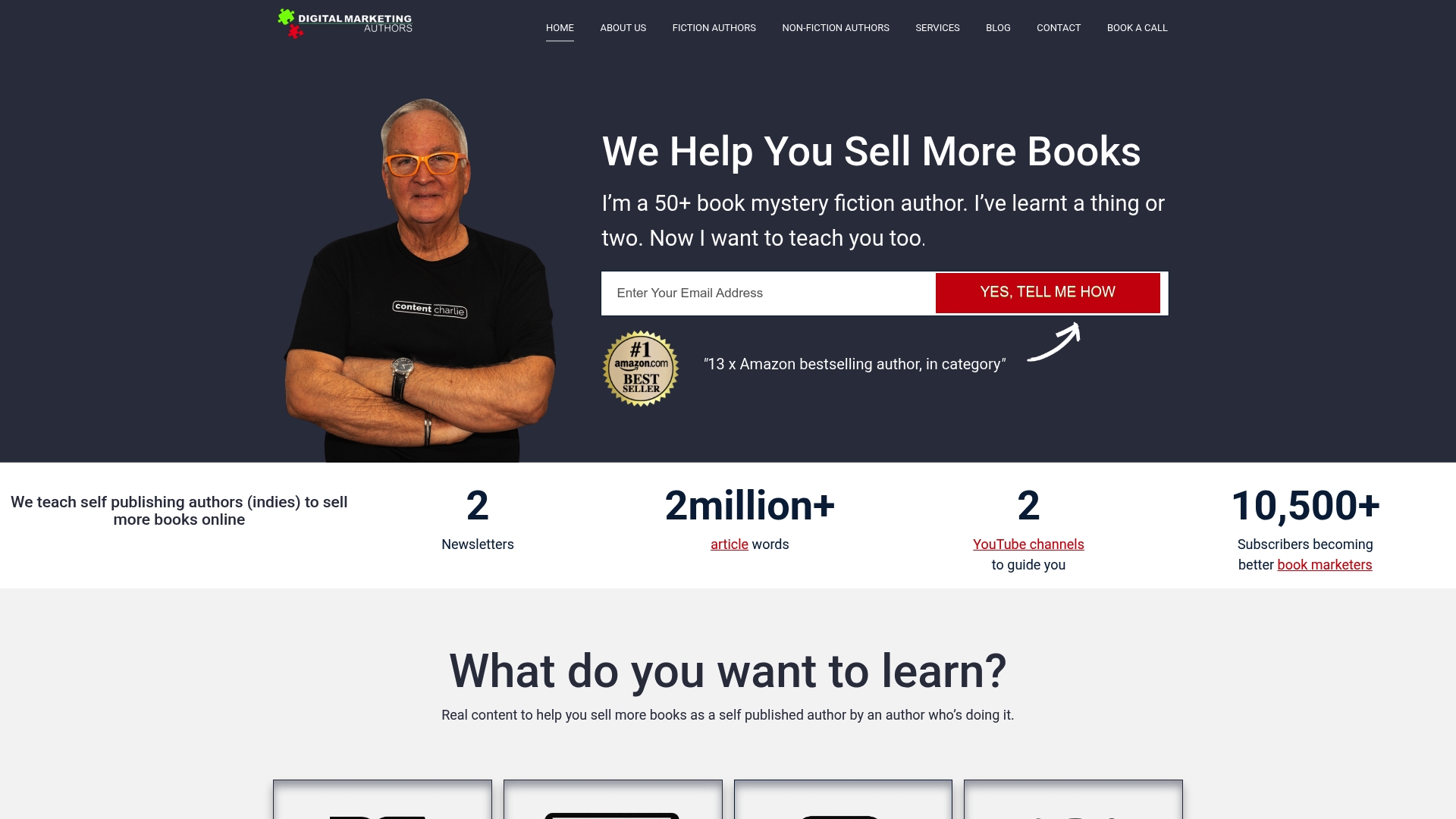- You are here:
- Home »
- Uncategorized »
- Digital Marketing Tips for Authors to Boost Book Sales

Digital Marketing Tips for Authors to Boost Book Sales
Over 80 percent of books fail to reach their intended audience, not because of poor writing, but because the right readers never find them. Many authors pour their energy into writing without a clear plan for connection. Targeted book marketing gives your work the best chance to reach the readers who will cherish it. Discover a practical way to focus your efforts and create genuine interest in your books.
Table of Contents
- Step 1: Define Your Ideal Reader Profile And Genre Niche
- Step 2: Build And Optimize An Author Website With Lead Magnets
- Step 3: Create Automated Email Sequences To Nurture Subscribers
- Step 4: Leverage Social Media And AI Tools For Book Promotion
- Step 5: Track Results And Refine Your Digital Marketing Strategy
Quick Summary
| Key Point | Explanation |
|---|---|
| 1. Define your ideal reader profile | Craft a specific reader profile to target your book marketing effectively, boosting reader engagement. |
| 2. Build an optimized author website | Design a professional website with lead magnets to convert casual visitors into dedicated readers. |
| 3. Create automated email sequences | Implement automated emails to nurture subscriber relationships and keep them engaged with your writing. |
| 4. Utilize social media and AI tools | Leverage social media analytics and AI for targeted marketing strategies that connect you with potential readers. |
| 5. Track and refine your marketing strategy | Regularly analyze performance metrics to adapt and improve your book promotion efforts continuously. |
Step 1: Define your ideal reader profile and genre niche
Creating a precise reader profile transforms your book marketing strategy from scattered efforts to targeted precision. By understanding exactly who will connect with your writing, you can craft messages that resonate deeply and attract readers who genuinely want your work.
Start by mapping out demographic and psychographic details. Who are the people most likely to love your book? Consider age range, gender, interests, reading habits, and lifestyle. According to research from NY Book Editors, identifying your ideal reader enables stronger storytelling through tailored language and narrative framing.
Quick profiling steps include analyzing readers of similar books in your genre. Look at Amazon reviews, book club discussions, and reader forums. What themes, character types, and story elements do they consistently praise? What emotional experiences are they seeking?
Your genre niche requires matching your unique storytelling passion with market demand. As Write Atlas suggests, a strong niche statement clarifies your specific audience and the distinctive value you provide.
Pro Tip: Create a detailed reader persona document. Give your ideal reader a name, background, and specific reading preferences. The more vivid and specific your profile, the more effectively you can target your marketing efforts.
By understanding your readers intimately, you transform book marketing from guesswork into a strategic conversation with the exact people most likely to become your loyal fans.
Step 2: Build and optimize an author website with lead magnets
Your author website is your digital storefront where potential readers first discover your literary world and connect with your brand. Creating a professional online presence with strategic lead magnets will transform casual visitors into committed readers and email subscribers.
According to research from My Codeless Website, professional design and compelling copywriting are crucial for author websites. Your site should showcase your unique writing style while offering valuable resources that engage potential readers.
Start by designing a clean professional website that reflects your genre and author personality. Include key elements like an author bio, book previews, and most importantly compelling lead magnets. These free resources can range from chapter excerpts and short stories to writing assessment tools or exclusive content that provides immediate value to your audience.
Create lead magnets specifically tailored to your reader profile. For fiction writers this might mean bonus character backstories. For nonfiction authors this could be a downloadable resource guide related to your book’s topic. The goal is offering something so intriguing that visitors willingly exchange their email address to receive it.
Pro Tip: Ensure your lead magnet delivery system is seamless. Use email marketing platforms that automatically send downloadable resources immediately after someone subscribes. This instant gratification increases the likelihood of engagement.
By strategically designing your website with targeted lead magnets, you transform casual web browsers into potential long term readers and email list subscribers who are genuinely interested in your writing.

Here’s a comparison of key elements for building an effective author website:
| Website Element | Purpose | Example for Fiction | Example for Nonfiction |
|---|---|---|---|
| Author Bio | Build trust & connect | Creative background | Subject matter expert |
| Book Previews | Generate interest | First chapter sneak peek | Downloadable sample chapter |
| Lead Magnets | Grow email list | Bonus character backstory | Topic resource guide |
| Professional Design | Reflect brand & genre | Genre-themed visuals | Clean, informative layout |
| Calls to Action | Encourage engagement | Subscribe for updates | Get your free checklist |
Step 3: Create automated email sequences to nurture subscribers
Automated email sequences transform casual subscribers into dedicated readers by delivering personalized content that builds genuine connections. Think of these sequences as a digital conversation that introduces your writing and keeps readers engaged without constant manual effort.
According to research from Armlin House, leveraging email marketing tools to segment your audience based on preferences enables more personalized communication. This targeted approach significantly increases the likelihood of converting subscribers into book buyers.
Design your email sequence with a strategic arc that mirrors a reader relationship. Start with a welcome email introducing yourself and delivering the promised lead magnet. Follow up with emails that provide value whether through writing insights, behind the scenes glimpses, or exclusive content related to your books.
Consider creating different sequences for different reader segments. Fiction writers might craft sequences that reveal character backstories or writing inspiration. Nonfiction authors could design sequences offering additional research insights or practical tips complementing their book’s themes.
Pro Tip: Space your emails strategically. Avoid overwhelming subscribers with daily messages. A well timed sequence might include a welcome email immediately after signup followed by emails spaced 3 to 7 days apart.
By thoughtfully crafting automated email sequences that provide consistent value, you transform subscribers from passive readers into active fans eagerly anticipating your next literary work.
Step 4: Leverage social media and AI tools for book promotion
Social media and AI tools have revolutionized book marketing by providing authors unprecedented ways to connect directly with potential readers. These powerful technologies enable you to create targeted promotional strategies that reach the right audience at the right time.
According to research from Blue Rose One, social media platforms offer valuable analytics to understand potential readers demographics and interests. By utilizing these insights strategically, you can craft precise marketing approaches that resonate with your ideal audience.
Start by selecting social media platforms where your target readers are most active. For fiction writers this might mean Instagram or TikTok. For nonfiction authors LinkedIn or Twitter could be more effective. Use platform specific features like stories polls and live sessions to create interactive content that builds community around your writing.
AI tools can supercharge your social media strategy by helping generate content ideas analyze audience engagement and even create promotional graphics. These technologies can help you understand which types of posts generate the most interest and optimize your marketing efforts with data driven insights.
Pro Tip: Conduct interactive surveys and polls through social media to directly engage your audience. This approach not only generates content ideas but also helps you understand reading preferences and potential book marketing strategies.
By combining strategic social media engagement with intelligent AI powered tools you transform book promotion from a guessing game into a precise targeted approach that connects you directly with readers who are most likely to love your work.
Step 5: Track results and refine your digital marketing strategy
Tracking and refining your digital marketing strategy transforms guesswork into precision targeting for your book promotion efforts. By systematically analyzing your marketing performance you can continuously improve your approach and maximize book sales.
According to research from Self Publishing Advice, focusing marketing efforts on a specific micro niche ensures that promotional activities resonate with the right readers. This means aligning every aspect of your marketing from book descriptions to social media engagement with your target audience.
Start by identifying key performance metrics that matter most to your book marketing goals. These might include email open rates social media engagement book preview downloads and actual book sales. Use analytics tools provided by platforms like Amazon social media sites and email marketing services to gather comprehensive data about your audience interactions.
Implement a regular review process where you examine these metrics monthly or quarterly. Look for patterns in what content generates the most interest what time of day your audience is most responsive and which platforms deliver the best conversion rates. This data driven approach allows you to make informed decisions about future marketing investments.
Pro Tip: Create a simple tracking spreadsheet that compares different marketing strategies and their corresponding results. This visual representation will help you quickly identify which approaches are most effective and where you should focus your future efforts.
By continuously tracking analyzing and refining your digital marketing strategy you transform book promotion from a static process into a dynamic responsive system that adapts to your readers changing preferences and behaviors.
Unlock Your Book’s Potential with Proven Digital Marketing Strategies
Struggling to transform your digital marketing efforts into real book sales can be frustrating. You know the importance of defining your ideal reader, building an engaging author website, and leveraging AI tools but applying these concepts strategically often feels overwhelming. This article highlights the need for a targeted marketing approach, automated email sequences, and data-driven refinement to reach and grow your loyal reader community.
At DigitalMarketingAuthors.com, we understand these challenges firsthand. Founded by 13x #1 Amazon bestselling author C.T. Mitchell, we specialize in helping indie authors build profitable author brands with step-by-step guidance on automating your book sales and using AI-powered tools to boost your visibility. With our proven systems, you can stop guessing and start marketing smarter, faster, and more effectively.
Looking to turn your marketing efforts into lasting success?

Visit DigitalMarketingAuthors.com today to learn how to craft magnetic email sequences and design a professional author website that converts visitors into loyal readers. Don’t wait until your next book launch — take control of your author brand now and watch your sales grow.
Explore essential strategies to grow your readership and automate your marketing with expert insights at DigitalMarketingAuthors.com. Start building your unstoppable author platform today.
Frequently Asked Questions
How can I identify my ideal reader profile to boost book sales?
Identifying your ideal reader profile helps you target your marketing efforts effectively. Start by analyzing demographic details such as age and interests, and psychographic details like reading habits. Create a detailed reader persona and use it to shape your marketing messages.
What essential elements should my author website include for effective marketing?
Your author website should include a professional author bio, book previews, and compelling lead magnets to attract visitors. Ensure your site visually reflects your genre and includes clear calls to action, prompting visitors to subscribe or engage further. Focus on key elements that reflect your brand and resonate with your audience.
What type of lead magnets can I create to grow my email list?
To grow your email list, offer lead magnets that appeal specifically to your reader profile. Examples include exclusive chapter excerpts, bonus content, or downloadable resources related to your book’s theme. Craft these lead magnets to provide immediate value and encourage visitors to exchange their email addresses for access.
How should I structure my automated email sequences to engage subscribers?
Structure your automated email sequences by starting with a welcome email that introduces yourself and provides the lead magnet. Then, follow up with valuable content over the next few weeks, spacing the emails 3 to 7 days apart. This consistent engagement keeps subscribers interested and helps build a relationship.
What social media strategies can I use to promote my book effectively?
Choose social media platforms where your target readers are active and create engaging content tailored to those platforms. Use interactive features like polls, stories, and live sessions to foster community around your writing. Tailor your posts based on analytics to understand and effectively reach your audience.
How can I track the effectiveness of my digital marketing efforts?
Track your digital marketing effectiveness by identifying key performance metrics like email open rates, social media engagement, and book sales. Regularly review these metrics—monthly or quarterly—to assess which strategies yield the best results, allowing you to refine your marketing approach as needed.

